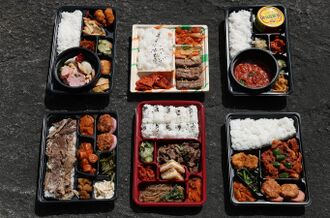Engineering:Dosirak
| Korean name (South Korea) | |
| Hangul | 도시락 |
|---|---|
| Revised Romanization | dosirak |
| McCune–Reischauer | tosirak |
| IPA | [to.ɕi.ɾak̚] |
| Korean name (North Korea) | |
| Hangul | 곽밥 |
|---|---|
| Revised Romanization | gwakbap |
| McCune–Reischauer | kwakpap |
| IPA | [kwak̚.p͈ap̚] |
Dosirak (Korean: 도시락), also known as Gwakbap (곽밥) refers to a packed meal, often for lunch. It usually consists of bap (밥, cooked rice) and several banchan (side dishes).[1][2] The lunch boxes, also called dosirak or dosirak-tong (dosirak case), are typically plastic or thermo-steel containers with or without compartments or tiers.[3] Dosirak is often home-made, but is also sold in train stations and convenience stores.[4][5]
Dosirak is derived from the Early Modern Korean word "도슭".[6] Records dating to the 18th century attest to this as well as other variations such as "밥고리", and "밥동고리".[7] The practice of packing food as done with dosirak isn't a unique practice to Korean Cuisine, and the modern dosirak can be seen as the Korean form of lunch boxes.
Varieties
Home-made dosirak is often packed in tiered lunch boxes that can separate bap (cooked rice) and banchan (side dishes).[8] The guk (soup) tier, if included, is usually kept warm by insulation.[9] Plastic or thermo-steel containers are most common, but combinations of wood and lacquer, ceramics and bamboo, as well as other materials, are also used.[10]
Yennal-dosirak (옛날 도시락; "old-time dosirak") consists of bap (rice), stir-fried kimchi, egg-washed and pan-fried sausages, fried eggs, and shredded gim (seaweed), typically packed in a rectangular lunchbox made of tinplate or German silver. It is shaken with the lid on, thereby mixing the ingredients prior to eating.[3][9] [11] Gimbap-dosirak (김밥 도시락; "packed gimbap"), made with sliced gimbap (seaweed rolls), is often packed for picnics.[12]
Gallery
See also
- Bento (弁当)
- Biandang (便當)
- Lunch box
- Packed lunch
- Tiffin
References
- ↑ "dosirak" (in ko). National Institute of Korean Language. http://stdweb2.korean.go.kr/search/View.jsp?idx=416483.
- ↑ "gwakbap" (in ko). National Institute of Korean Language. http://stdweb2.korean.go.kr/search/View.jsp?idx=32419.
- ↑ 3.0 3.1 "What the world eats for lunch". The Daily Meal. 24 September 2012. http://www.foxnews.com/food-drink/2012/09/24/what-world-eats-for-lunch.html.
- ↑ Hong, Ji-yeon (17 February 2016). "Local specialties take train travel to a new level". Korea JoongAng Daily. http://koreajoongangdaily.joins.com/news/article/article.aspx?aid=3015129&ref=mobile.
- ↑ Park, Han-na (15 October 2015). "Convenience stores vie for lunch box market". The Korea Herald. http://www.koreaherald.com/view.php?ud=20151015001192.
- ↑ "도슭" (in en), Wiktionary, the free dictionary, 2022-02-19, https://en.wiktionary.org/w/index.php?title=%EB%8F%84%EC%8A%AD&oldid=65870970, retrieved 2023-10-12
- ↑ "홈 > 소장 자료 (상세보기) - 『청구영언』 김천택 편, 영인편 | 국립한글박물관 NATIONAL HANGEUL MUSEUM". https://www.hangeul.go.kr/bbs/publicBbsView.do?bbs_id=4&bbs_no=33&curr_menu_cd=0106040000.
- ↑ Frizzell, Nell (24 July 2014). "Store-Bought Lunch Is Stupid and Wasteful". Munchies (VICE). https://munchies.vice.com/en_us/article/store-bought-lunch-is-stupid-and-wasteful.
- ↑ 9.0 9.1 Williams, Maxwell (30 March 2017). "5 Best Lunches In the World". GOOD magazine. https://food.good.is/articles/lunchboxes-around-the-world.
- ↑ Kim, Hyung-eun (2 May 2017). "Korean dining on view in London : Craft Week showcases fine objects used in eating and drinking". Korea JoongAng Daily. http://koreajoongangdaily.joins.com/news/article/article.aspx?aid=3032859.
- ↑ Bolat, Jeff. "Oversigt over danske måltidskasser". https://www.maaltidskassen.com/.
- ↑ Kayal, Michele (3 July 2012). "Thinking Outside The Bento Box". NPR. https://www.npr.org/2012/07/03/156199639/thinking-outside-the-bento-box.
 |










